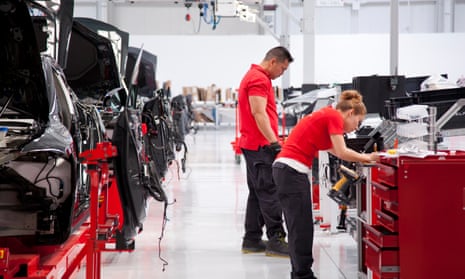Tesla factory workers were injured at a rate 31% higher than industry average – and seriously injured at a rate more than double the industry average – in 2015, according to a new report from a worker safety organization.
The report gives the most complete picture to date of injury rates at Tesla’s factory in Fremont, California. Tesla has strenuously defended its safety record since workers went public with complaints in February and announced they were seeking to unionize with the United Auto Workers. The Guardian recently published an investigation into the factory, where some workers allege that aggressive production goals set by CEO Elon Musk have resulted in unsafe conditions and avoidable injuries.
An analysis of factory injury logs published by the California not-for-profit Worksafe on Wednesday revealed Tesla’s performance since 2014 on two official metrics that are reported to workplace safety regulators.
The first is total recordable incident rate (TRIR), which accounts for the total number of illnesses and injuries in a workplace per 100 workers.
Tesla’s total incident rate was 15% higher than the industry average in 2014 and 31% higher than the industry average in 2015. In 2016, Tesla’s TRIR was 8.1. The federal government has not yet released the industry average for 2016, but since 2008 the annual average has ranged from 6.7 to 7.7.
The second metric is days away, restricted duty or transfer rate (Dart), which looks at the number of days a worker is either absent from work or restricted from his usual tasks due to an injury. Worksafe said Dart is a good indicator of serious injuries, since they result in lost work time.
Tesla’s Dart was 69% higher than the industry average in 2014, and 103% higher than the industry average in 2015. In 2016, Tesla’s Dart was 7.3. The federal government has not yet released the industry average for 2016, but since 2008 the annual average has ranged from 3.8 to 4.2.
“We may have had some challenges in the past as we were learning how to become a car company, but what matters is the future and with the changes we’ve made, we now have the lowest injury rate in the industry by far,” a Tesla spokesperson said in a statement responding to the Worksafe report.
In an interview with the Guardian on 12 May, Tesla CEO Elon Musk acknowledged that workers had been “having a hard time, working long hours, and on hard jobs” but said he and the company cared deeply about safety. Tesla published a blogpost asserting that its TRIR for the first three months of 2017 was 32% lower than the industry average of 6.7.
“This data shows that there has been a dramatic improvement in employee safety, we are now significantly better than industry-average, and we continue to improve each day,” the company wrote. “A few anecdotes in a factory of over 10,000 people can always be given, but these are the facts.”
Tesla refused to provide the Guardian with complete data for previous years, however, arguing that it “doesn’t reflect how the factory operates today”. The company did not dispute the Guardian’s assertion that its TRIR was above the industry average from 2013 through 2016.
WorkSafe obtained Tesla’s injury logs from a factory worker who requested them from the company in April. Federal and state law require employers to maintain a detailed log of workplace injuries and illnesses, and to provide a copy of the log to employees upon request.
In its report, Worksafe questioned Tesla’s assertion that its safety record is significantly better in 2017, writing that three months is “not a sufficient length of time to accurately identify a meaningful and lasting trend in injury reduction”.
Worksafe also raised concerns about Tesla’s record keeping. The injury logs that Tesla provided to its employee were initially missing 135 injuries from 2016 and 46 injuries from the beginning of 2017. The company subsequently revised the logs and provided a new version to the employee.
Tesla said that its 2017 TRIR was calculated after the additional 46 injuries were added to the logs. It is unclear how Tesla is supporting its assertion that its injury rate is the lowest in the industry, given that the government only releases an industry average and rates by company are not publicly available.

Comments (…)
Sign in or create your Guardian account to join the discussion